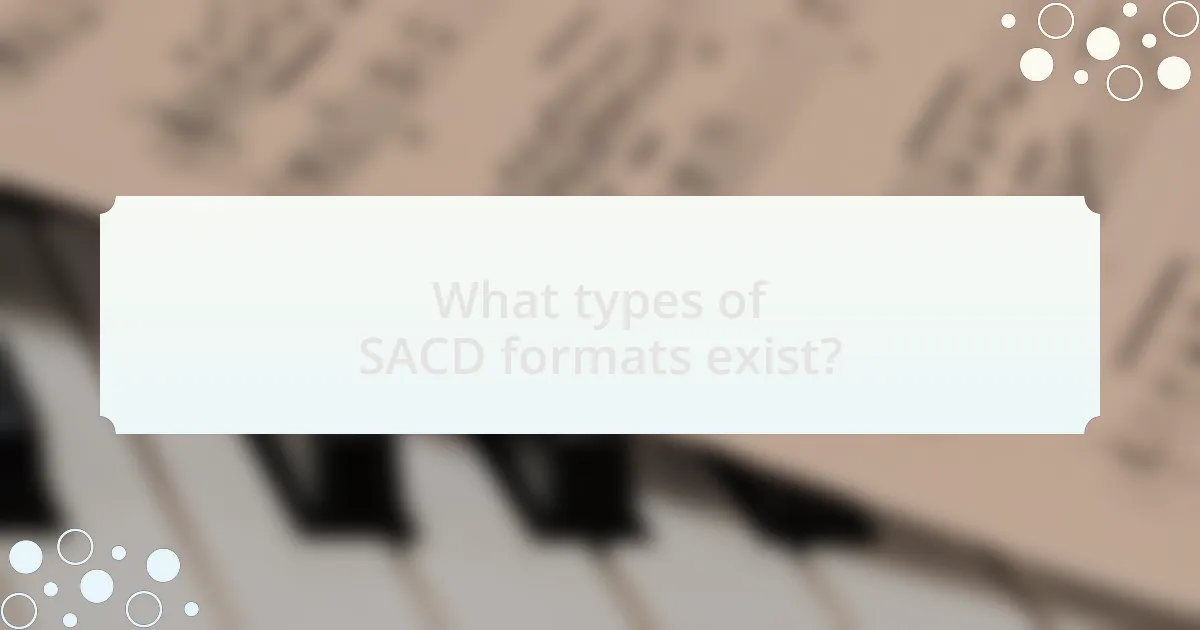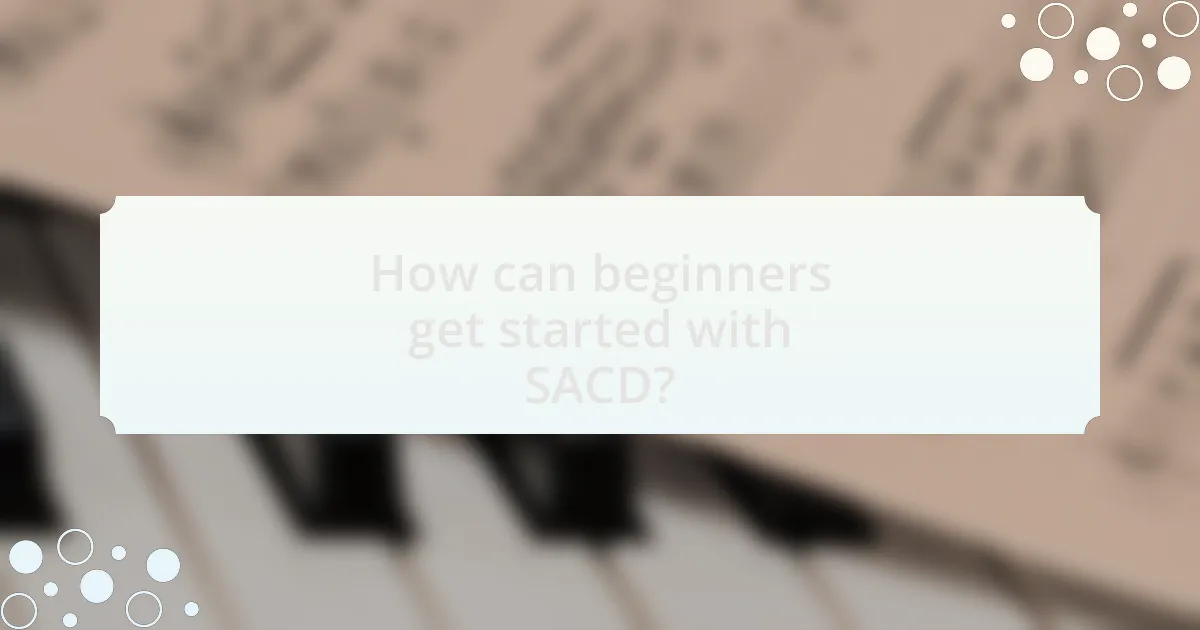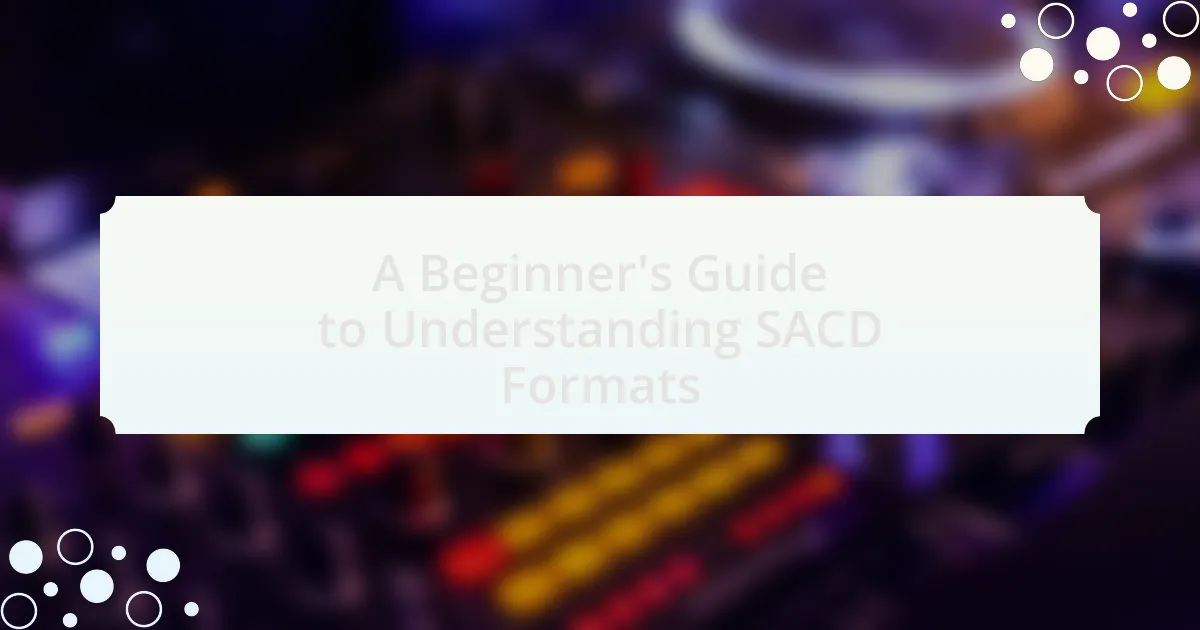SACD, or Super Audio CD, is a high-resolution audio format developed by Sony and Philips, designed to deliver superior sound quality through Direct Stream Digital (DSD) encoding. This article provides a comprehensive overview of SACD, detailing its technical specifications, differences from standard CDs, and the significance of its multi-channel capabilities. It also explores the various types of SACD formats, including hybrid and single-layer discs, and offers guidance for beginners on how to start building an SACD collection, including equipment requirements and troubleshooting tips. The content aims to enhance understanding of SACD’s advantages for audiophiles and casual listeners alike.
What is SACD Format?

SACD, or Super Audio CD, is a high-resolution audio format developed by Sony and Philips, introduced in 1999. This format supports both stereo and multi-channel audio, providing a richer sound experience compared to standard CDs. SACD utilizes a technology called Direct Stream Digital (DSD), which captures audio at a higher sampling rate than traditional PCM formats, resulting in improved sound quality. The SACD format is capable of delivering audio with a frequency response up to 100 kHz, significantly exceeding the limits of standard CDs, which typically offer a maximum of 20 kHz.
How does SACD differ from other audio formats?
SACD, or Super Audio CD, differs from other audio formats primarily in its ability to deliver high-resolution audio through a unique DSD (Direct Stream Digital) encoding method. Unlike standard CDs that use PCM (Pulse Code Modulation) at a resolution of 16-bit/44.1 kHz, SACD supports higher bit rates and sampling frequencies, allowing for 1-bit/2.8224 MHz audio, which results in a more detailed and dynamic sound experience. This high-resolution capability is further enhanced by SACD’s multi-channel audio support, enabling surround sound formats that standard CDs do not offer.
What are the technical specifications of SACD?
The technical specifications of Super Audio CD (SACD) include a storage capacity of up to 4.7 GB for single-layer discs and 8.5 GB for dual-layer discs. SACD utilizes Direct Stream Digital (DSD) encoding, which operates at a sampling rate of 2.8224 MHz, significantly higher than the standard CD’s 44.1 kHz. This format supports multi-channel audio, allowing for up to six channels (5.1 surround sound). Additionally, SACD can be played in a hybrid format, which includes a standard CD layer for compatibility with regular CD players. These specifications enable SACD to deliver high-resolution audio quality, making it a preferred choice for audiophiles.
Why was SACD developed?
SACD was developed to provide a high-resolution audio format that enhances sound quality beyond that of standard CDs. The introduction of SACD aimed to meet the growing demand for superior audio experiences, particularly in the context of classical music and audiophile recordings. It utilizes a technology called Direct Stream Digital (DSD), which captures audio at a much higher sampling rate than traditional PCM formats, resulting in greater detail and clarity. This development was also a response to the limitations of CD audio, which, while revolutionary, could not fully capture the nuances of live performances.
What are the key features of SACD?
The key features of SACD (Super Audio CD) include high-resolution audio, multi-channel sound capabilities, and a hybrid disc format. SACD supports audio sampling rates up to 2.8224 MHz, which is significantly higher than standard CDs, allowing for greater detail and clarity in sound reproduction. Additionally, SACDs can contain both stereo and multi-channel audio tracks, providing an immersive listening experience. The hybrid format allows SACDs to be played on standard CD players, making them accessible while still offering enhanced audio quality on compatible SACD players.
How does SACD achieve high-resolution audio?
SACD achieves high-resolution audio through its use of Direct Stream Digital (DSD) encoding, which captures audio at a much higher sampling rate than standard CDs. DSD operates at a sampling rate of 2.8224 MHz, significantly exceeding the 44.1 kHz of traditional CDs, allowing for a more accurate representation of sound waves. This high sampling rate results in a broader frequency response and improved dynamic range, enhancing the overall audio quality. Additionally, SACD supports multi-channel audio, providing an immersive listening experience that further contributes to its high-resolution capabilities.
What is the role of DSD in SACD?
DSD, or Direct Stream Digital, serves as the primary audio encoding format for Super Audio CDs (SACD). This format utilizes a 1-bit delta-sigma modulation technique, which allows for high-resolution audio reproduction, capturing sound at a sampling rate of 2.8224 MHz, significantly higher than standard CDs. The implementation of DSD in SACD enables a more accurate representation of audio signals, resulting in improved sound quality and dynamic range. This is supported by the fact that DSD’s high sampling rate and low noise floor contribute to a more natural and detailed listening experience, distinguishing SACD from traditional CD formats.
What types of SACD formats exist?

There are two main types of SACD formats: single-layer SACD and hybrid SACD. Single-layer SACDs contain only the high-density SACD layer, while hybrid SACDs include both a SACD layer and a standard CD layer, allowing playback on both SACD and regular CD players. This distinction is crucial for understanding the compatibility and audio quality offered by each format.
What are the differences between hybrid and single-layer SACDs?
Hybrid SACDs contain both a Super Audio CD layer and a standard CD layer, allowing playback on both SACD and standard CD players. In contrast, single-layer SACDs only include the Super Audio CD layer, which means they can only be played on SACD-compatible devices. This distinction allows hybrid SACDs to offer greater compatibility with a wider range of playback equipment, while single-layer SACDs provide a higher fidelity experience exclusively for SACD players.
How do hybrid SACDs work?
Hybrid SACDs work by combining a standard CD layer with a high-density Super Audio CD (SACD) layer on a single disc. This dual-layer structure allows the disc to be played on both standard CD players and SACD players, providing compatibility across different audio systems. The SACD layer utilizes Direct Stream Digital (DSD) encoding, which offers higher audio fidelity compared to the traditional Pulse Code Modulation (PCM) used in standard CDs. This design enables listeners to experience superior sound quality on compatible devices while maintaining accessibility for those with standard CD players.
What are the advantages of single-layer SACDs?
Single-layer SACDs offer several advantages, primarily their simplicity and compatibility. These discs contain only a single layer of high-density data, which allows for straightforward playback on SACD players without the need for additional layers or formats. This design results in enhanced audio quality due to reduced signal loss and interference, as the single layer minimizes the complexity of the reading process. Furthermore, single-layer SACDs are often more affordable to produce, making them accessible to a wider audience. Their compatibility with standard CD players also allows users to enjoy the content, albeit in standard resolution, broadening their usability.
What is the significance of multi-channel SACD?
Multi-channel SACD is significant because it enhances the listening experience by providing immersive sound through multiple audio channels. This format allows for a more realistic representation of music, as it can reproduce sound from various directions, mimicking a live performance environment. The multi-channel capability of SACD supports up to six channels, enabling a surround sound experience that traditional stereo formats cannot achieve. This is particularly beneficial for genres like classical and jazz, where spatial audio can greatly enhance the perception of depth and clarity. The introduction of multi-channel SACD has also contributed to the resurgence of high-fidelity audio, appealing to audiophiles seeking superior sound quality.
How does multi-channel SACD enhance the listening experience?
Multi-channel SACD enhances the listening experience by providing a more immersive sound environment through the use of multiple audio channels. This format allows for sound to be distributed across various speakers, creating a three-dimensional audio landscape that traditional stereo formats cannot achieve. Research indicates that listeners often report a heightened sense of realism and spatial awareness when engaging with multi-channel SACD recordings, as the sound can be positioned around them, mimicking a live performance setting. This capability is supported by the SACD’s high-resolution audio quality, which captures more detail and nuance in the music, further enriching the overall auditory experience.
What are the requirements for playing multi-channel SACDs?
To play multi-channel SACDs, a compatible SACD player is required, as standard CD players do not support the multi-channel audio format. Additionally, a multi-channel audio system, such as a home theater setup with at least five speakers and a subwoofer, is necessary to fully experience the surround sound capabilities of multi-channel SACDs. These requirements ensure that the high-resolution audio and immersive sound experience intended by the SACD format can be achieved.
How can beginners get started with SACD?

Beginners can get started with SACD by acquiring a compatible SACD player and selecting SACD discs to play. SACD, or Super Audio CD, requires specific hardware that supports its high-resolution audio format, which is distinct from standard CD players. Many modern Blu-ray players also support SACD playback, making them a viable option. Additionally, beginners should explore the catalog of available SACD titles, which includes classical, jazz, and popular music, to fully experience the enhanced audio quality that SACD offers.
What equipment do you need to play SACDs?
To play SACDs, you need a compatible SACD player or a universal disc player that supports SACD format. SACD players are specifically designed to read the high-density optical discs that contain Super Audio CD content, which includes both stereo and multi-channel audio. Universal players can also play standard CDs and DVDs in addition to SACDs, providing versatility. The necessity for a compatible player is due to the unique encoding and data storage methods used in SACDs, which standard CD players cannot interpret.
What are the best SACD players available?
The best SACD players available include the Sony UBP-X800M2, the Marantz SA-10, and the Oppo UDP-205. The Sony UBP-X800M2 is known for its versatility, supporting various formats and offering high-quality audio playback. The Marantz SA-10 is recognized for its exceptional sound quality and advanced digital-to-analog conversion technology. The Oppo UDP-205 is praised for its robust build and outstanding audio performance, making it a favorite among audiophiles. These players are highly regarded for their performance and features in the SACD market.
How do you connect an SACD player to your audio system?
To connect an SACD player to your audio system, use either HDMI or analog outputs. HDMI provides a digital connection that supports high-resolution audio formats, while analog outputs typically consist of stereo RCA cables for standard audio connections. Ensure that your audio system has compatible inputs; for HDMI, connect to an AV receiver or TV with HDMI ports, and for analog, connect the RCA cables to the corresponding audio inputs on your amplifier or receiver. This method allows for optimal sound quality and compatibility with various audio formats, including SACD’s multi-channel audio capabilities.
What are some tips for building an SACD collection?
To build an SACD collection, focus on acquiring titles that are well-reviewed and known for their audio quality. Start by researching essential albums in genres you enjoy, as many classic and contemporary recordings are available in SACD format. Utilize resources like online forums, audiophile websites, and music review platforms to identify must-have SACDs. Additionally, consider purchasing from reputable retailers or second-hand shops that specialize in high-fidelity audio formats to find rare or out-of-print titles. Prioritize collecting hybrid SACDs, which contain both SACD and standard CD layers, allowing for versatile playback options.
Where can you find quality SACD titles?
Quality SACD titles can be found at specialized music retailers, online marketplaces, and dedicated audiophile websites. Retailers such as Acoustic Sounds and Elusive Disc offer a wide selection of high-quality SACD titles, often focusing on audiophile-grade releases. Online platforms like Amazon and eBay also provide access to both new and used SACDs, allowing for a broader search. Additionally, labels such as Sony and Universal Music frequently release SACD editions of classic albums, ensuring that collectors can find quality titles directly from the source.
How do you choose SACDs based on music genres?
To choose SACDs based on music genres, first identify the specific genre you prefer, such as classical, jazz, rock, or pop. Each genre often has dedicated SACD releases that enhance the listening experience through superior sound quality and multi-channel audio. For instance, classical music SACDs frequently feature orchestral performances recorded in high-resolution formats, while jazz SACDs may include live recordings that capture the ambiance of the performance. Additionally, researching labels known for high-quality SACD releases, such as Analogue Productions or MoFi, can guide you to genre-specific selections. This approach ensures that you select SACDs that not only align with your musical tastes but also utilize the format’s capabilities to deliver an optimal auditory experience.
What common issues might beginners face with SACD?
Beginners may face several common issues with SACD, including compatibility problems, limited player options, and a lack of understanding of the format’s features. Compatibility issues arise because not all CD players support SACD playback, which can lead to frustration when attempting to listen to SACD discs. Additionally, the market for SACD players is smaller compared to standard CD players, limiting choices for consumers. Lastly, beginners often struggle to grasp the differences between SACD and other formats, such as standard CDs or DVD-Audio, which can hinder their ability to fully appreciate the benefits of SACD, such as higher audio quality and multi-channel sound.
How can you troubleshoot playback problems with SACDs?
To troubleshoot playback problems with SACDs, first ensure that your player is compatible with SACD formats, as not all CD players support them. If compatibility is confirmed, check the connections and cables to ensure they are secure and functioning properly. Additionally, inspect the SACD for scratches or dirt that may affect playback; cleaning the disc gently with a soft cloth can resolve issues caused by surface contaminants. If problems persist, try playing the SACD in a different player to determine if the issue lies with the disc or the original player.
What should you know about SACD compatibility with other formats?
SACD, or Super Audio CD, is primarily compatible with standard CD players, but it requires specific hardware to fully utilize its high-resolution audio capabilities. While SACDs can be played in standard CD players, they will only output the audio in CD quality, not the higher fidelity that SACD offers. Additionally, SACD players are designed to read both the SACD layer and the CD layer, ensuring compatibility with both formats. This dual-layer structure allows for broader playback options, but to experience the full benefits of SACD, a dedicated SACD player is necessary.

Leave a Reply